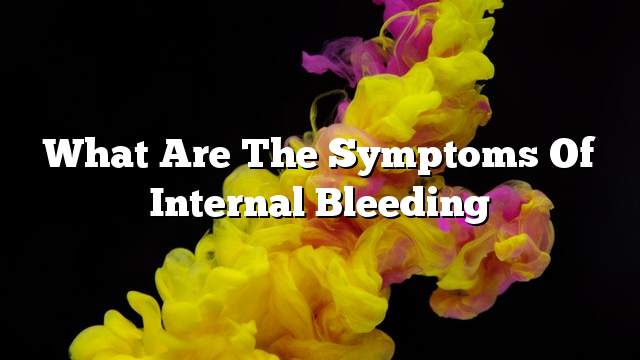Internal bleeding
Internal bleeding occurs when a blood vessel is exposed to rupture, causing the blood to circulate out of the circulatory system and collect it inside the body. The amount of bleeding depends on the size of the damage to the injured member, the volume of the blood vessel causing the bleeding, as well as the ability of the body to deal with this bleeding.
Internal bleeding is called this name because it is not seen by the naked eye in many cases. Here is the difficulty of diagnosing a person’s bleeding. If blood clotting is formed in sufficient size to pressure neighboring organs and prevent them from functioning properly. Internal bleeding can occur anywhere in the body, whether in tissues, internal organs, or cavities such as the skull, spine, chest, or abdomen. It may also develop in the eyes, heart tissue, muscles, or joints.
Symptoms of internal bleeding
The symptoms of internal bleeding vary depending on where the bleeding occurs, the amount of damage to the blood vessel, and the speed of bleeding. It is difficult in many cases to diagnose internal bleeding, but there are several symptoms and signs to help the suspicion of the occurrence, including:
- Feelings of abdominal pain : This offer may not be specific to internal bleeding, but feeling it suddenly without any known reason calls for a doctor, especially if the person is vulnerable to internal bleeding.
- The appearance of blood with vomiting This blood may be light red or dark, or may be mixed with vomiting.
- The presence of blood with stool : This is precisely when the internal bleeding in the digestive system, and the color of blood is an important factor to know where the bleeding; if the color is light red means that bleeding occurred in the lower digestive system, and black or blood mixed with stool indicates bleeding in part Lift it up.
- If the development of bleeding is slow it causes the appearance of certain symptoms : Feeling very tired, or weakness of muscles, or pale skin, or even difficulty breathing.
- Blood Cough : This is the appearance of blood in the form of filaments with phlegm, or the emergence of blood of light red color, or rust rust when coughing, and this is an unusual symptom of internal bleeding as it may arise from many other causes more common.
- Vaginal bleeding : It comes in the form of severe menstrual bleeding and irregular, that is, it comes in large quantities and at long intervals and in time, as well as bleeding from the vagina for women in menopause.
- Exits blood with urine : In many cases it occurs in small amounts that can only be seen by a microscope. This may indicate damage to the kidneys, bladder, or any part of the urinary tract.
- The occurrence of space syndrome : In some cases may occur bleeding within the muscles causing swelling, and thus increase the pressure in the muscle strictly supply the blood, and damage to the nerves feeding it, and this syndrome usually result from exposure to fractures in the bone or muscle injuries, and then feel numb, and difficulty Move the infected muscle.
- Feeling pain in the joints : This feeling is especially felt in people with internal bleeding who already suffer from disorders of blood clotting, or those who take anticoagulants, and this pain arises from pressure from the blood pool in or around the joints.
- Getting into shock , Known as the medical term (Shock), and this is one of the most important symptoms that occur with severe internal bleeding, and usually result from the decline in circulation due to bleeding. The symptoms of this condition are: increased heart rate, decreased blood pressure, increased sweating, and disturbed mental state of the patient. These symptoms worsen if the bleeding continues.
- Head bleeding : It has several symptoms, such as head pain, a feeling of general weakness in the body, problems with vision or speech, and impaired mental state.
Cases where you should see your doctor
Internal bleeding has serious complications and consequences, and since it is difficult to diagnose and watch, those who are exposed to internal bleeding and experience one of the above symptoms should see a doctor, especially if he suffers from the following symptoms:
- Very rapid heartbeat.
- Feeling sharp pains, especially in the abdomen.
- Bleeding during pregnancy.
- Feeling chest pain, or feeling very short of breath.
- Exposure to paralysis or inability to move any part of the body.
- Blue spots appear around nails or lips.
- Mental disorder or loss of consciousness.
- Lack of urinary incontinence.
- The skin becomes very cold.
- Feeling very weak and weak.
